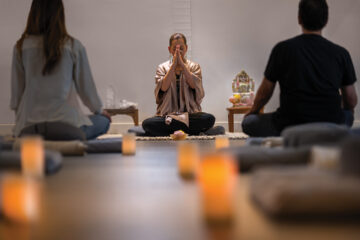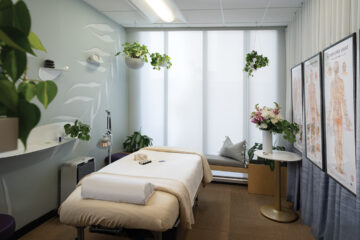Stay Healthy During The Holidays

The holidays are a prime time for colds, thanks to a combination of high stress levels and the decreased physical activity of winter months. The Centers for Disease Control and Prevention estimates that U.S. children lose more than 22 million school days to the common cold; the average adult contracts two to three colds per year. If you fall victim despite your rigorous hand-washing routine, remember that colds are viral, not bacterial, so doctor visits and antibiotics offer little relief. The road to wellness can be low impact and low cost, involving little more than a cup of tea, a warm bath, and conscious breathing.
Tea Time
Tea and tisane — better known as herbal and spice teas — are age-old bedside remedies for combating colds. Tea is a cornerstone of Eastern medicine widely utilized for its healing properties.
“Green tea provides a fantastic amount of antioxidants and polyphenols, stress-reducing and immune-boosting compounds that are wonderful for the whole system and really great to maintain your health throughout the winter,” says Gregor Bertram of Arogya Holistic Healing in Westport, Connecticut.
While green tea is often considered the champion among wellness-enhancing teas, rooibos and tulsi also hold powerful medicinal properties. Rooibos, a caffeine-free herbal tea harvested in South Africa, is antioxidant rich and also known for its anti-inflammatory and anti-allergic powers. Tulsi, or holy basil, is an herb native to India known for its incredible phytochemical properties, “which help to promote health and fight stress,” notes Bertram.
Sourcing these teas, however, leaves a serious environmental impact, especially if they are traveling thousands of miles from plant to teapot. But there are local alternatives. Traditional culinary herbs such as rosemary, thyme, and mint also improve digestion and circulation. Further, chamomile, calendula, Echinacea, and fennel can be sourced locally at farmers’ markets or grown in home gardens.
While many medicinal herbs and spices can be grown at home, no two teas or tisanes are treated the same. Bertram suggests consulting an expert before starting a tea regime to maximize healing benefits.
Sweat It Out
Long before the emergence of luxury day spas and hydrotherapy treatments, Native American tribes used sweat lodges to rid their bodies of fevers and colds, according to Marybetts Sinclair’s Modern Hydrotherapy for the Massage Therapist. And Turkish and Roman bathhouses served not only as settings for social rituals, but were also places to cleanse the body of harmful viruses. Connecticut-based naturopathic physician Mark J. Romano suggests that taking a hot bath can alleviate stress and sweat viruses out of the body by inducing a fever. “I prescribe it to my patients, and I do it myself,” says Romano. “It’s a really good way to boost your immunity and help your body fight off a virus with a fever.”
By soaking in a hot bath for about 20 minutes and raising the body’s temperature up to 101 degrees Fahrenheit, it creates a natural immunity to start to fight the virus.
Deep Breathing
Eat well. Exercise regularly. While these are essential to a healthy lifestyle, a third element is often overlooked: a mind-body practice. The Chinese practice of qigong (pronounced “chee-gong”) combines the consciousness of breath and air — “qi” — with the work to cultivate and balance this energy — “gong.”
“The three points [exercise, nutrition, and mind-body practice] are all necessary,” says Tom Rogers, vice president of the Qigong Institute in Los Altos, California. “The number-one reason you need a mind-body practice is [to relieve] stress, [which] causes so much illness — between 70 percent and 90 percent — and can make illness worse.”
There are different manifestations of qigong, but basic exercises involve adjusting one’s posture, breath, and awareness of mental state, which are actions that can be incorporated into everyday activities. Movement forms of qigong include the popular tai chi.
Rogers suggests that qigong is accessible to people of all physical abilities, and since the foundation of qigong is consciousness and movement of breath, it is an intrinsically free practice.
“You do the three simple adjustments in qigong; you get your ‘MBA’ — movement, breathing and awareness,” says Rogers. “Traditional Chinese medicine says that you get sick because you don’t have enough energy, or qi, because it’s blocked. By doing qigong, you can take care of unblocking your energy.”
And qigong forces people to confront the present, a key aspect in alleviating stress. “Qigong is not something you just want to go into the gym to do,” says Rogers. “The spiritual part of qigong, which is built into the practice itself, is being present and being in the moment.”
Building these practices into the holiday months will help to alleviate the added stress of the season — and keep colds at bay, too. ALEXANDRA GROSS









Comments